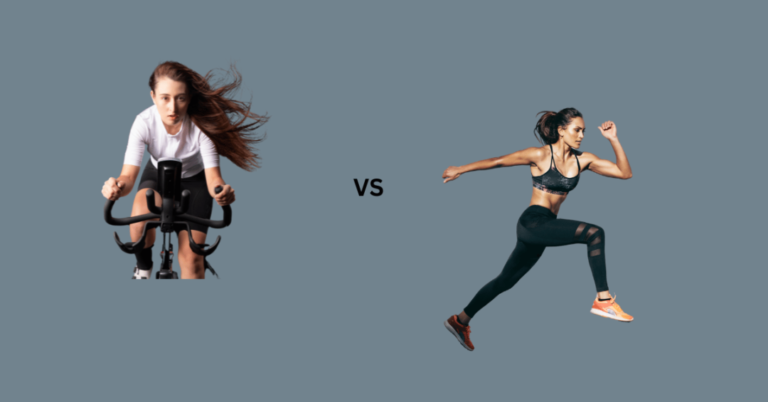Muscles Used In Cycling: What Muscles Does Biking Work?
Some links on this page are affiliate links (including Amazon Associate links) which means that, if you choose to make a purchase, we may earn a small commission at no extra cost to you. We greatly appreciate your support!

Muscles Used In Cycling: What Muscles Does Biking Work?
When you ride a bike, you’re not just moving from one place to another – you’re giving your whole body a workout! Have you ever wondered what muscles does biking work? From your legs pushing the pedals to your core keeping you steady and even your arms helping with balance, biking uses a lot of muscles.
In this article, we’ll explore all the different muscles that come into play when you ride a bike. Whether you’re new to cycling or looking to improve your fitness, understanding how biking works your muscles can help you get the most out of your ride. Let’s begin and discover how cycling can strengthen your body and boost your overall health!
What Muscles Does Cycling Work?

Cycling is a comprehensive workout that engages multiple muscle groups throughout the body. From the pedal stroke to maintaining balance, cycling can significantly enhance strength, endurance, and overall fitness. Here’s a closer look at the primary muscles worked during cycling:
1. Muscles Used In The Pedal Stroke
The pedal stroke in cycling is a coordinated effort involving several key muscles in the lower body. The primary muscles engaged include:
- Quadriceps: The quad muscles, located at the front of the thigh, are crucial during the downstroke phase, where they extend the knee to push the pedal down.
- Hamstrings: Situated at the back of the thigh, the hamstrings work during the upstroke phase, helping to pull the pedal up.
- Gluteus Maximus: This powerful glute muscle mass in the buttocks is engaged during the downstroke, providing additional force and stability.
- Calves: The gastrocnemius and soleus calf muscles are involved throughout the pedal cycle, aiding in both pushing down and lifting up the pedal.
These muscles work together in a seamless motion, propelling the bike forward and allowing for efficient power transfer from the legs to the pedals.
2. Core Muscles Used In Cycling
Cycling also requires a strong and stable core to maintain posture, balance, and control. The core muscles play a vital role in balance and stability for the upper body and, provide a solid foundation for powerful leg movements. Key core muscles used in cycling include:
- Abdominals: The rectus abdominis, obliques, and transverse abdominis work to stabilize the torso and maintain balance during cycling.
- Lower Back Muscles: The erector spinae and other lower back muscles support the spine, helping to keep the rider upright and balanced.
- Hip Flexors: The iliopsoas and other hip flexors are engaged to lift the legs during the pedal stroke, contributing to a smooth and efficient cycling motion.
A strong core not only enhances cycling performance but also helps prevent the risk of injury by reducing strain on the lower back and improving overall stability.
3. Upper Body Muscles Worked By A Cyclist
While cycling is predominantly a lower-body exercise, the upper body is also important, especially during long rides and challenging terrains. The upper body muscles provide support, control, and power, contributing to a well-rounded workout. Important upper body muscles used in cycling include:
- Shoulders: The deltoids and trapezius muscles in the shoulders help stabilize the arms and upper body, especially when riding out of the saddle or maneuvering through turns.
- Arms: The biceps and triceps are engaged in gripping the handlebars and controlling the bike, providing necessary support and stability.
- Chest: The pectoral muscles assist in maintaining upper body posture and stability, particularly when leaning forward during intense cycling sessions.
- Upper Back: The rhomboids and latissimus dorsi work to keep the shoulders stable and aid in maintaining a proper riding position.
By engaging these upper body muscles, cyclists can enhance their overall endurance and performance, ensuring a balanced and effective workout.
Summary
Cycling is an excellent full-body workout that targets multiple muscle groups, from the powerful muscles in the legs to the stabilizing core and upper body muscles. This makes cycling not only a great cardiovascular exercise but also a valuable strength training activity that promotes overall fitness and well-being.
Maximizing Cycling Performance Through Muscle Training

To enhance cycling performance, cyclists can incorporate specific muscle training techniques that focus on strength, endurance, and efficiency. By targeting key muscle groups and optimizing their activation, cyclists can improve both their power output and endurance capacity. Here’s how muscle training can maximize cycling performance:
1. Using Strength Training For Muscle Enhancement
Strength and conditioning training plays an important role in developing the muscles necessary for cycling. By focusing on targeted exercises, cyclists can:
- Build Leg Strength: Exercises like squats, lunges, and leg presses strengthen the quadriceps, hamstrings, calves, and glutes, improving pedal power and efficiency.
- Strengthen Core Muscles: Incorporating core exercises such as planks, Russian twists, and bicycle crunches enhances core strength, stability, and balance which is essential for maintaining proper cycling posture.
- Include Upper Body Workouts: While cycling primarily involves the lower body, working the upper body with exercises like rows, push-ups, and shoulder presses can provide additional stability and power during sprints and climbs.
Integrating strength training sessions into a cyclist’s routine can lead to noticeable improvements in muscle strength and overall performance on the bike.
2. Endurance Building For Cyclists
Endurance is crucial for cyclists, especially during long rides and races. Specific training techniques to improve endurance include:
- Long-Distance Rides: Regularly incorporating longer rides into training helps build cardiovascular endurance and teaches the body to sustain effort over extended periods.
- Interval Training: Alternating between periods of high-intensity efforts and recovery helps improve aerobic capacity and endurance.
- Hill Climbing: Incorporating hill repeats into training sessions strengthens leg muscles and improves endurance while simulating race conditions.
Building endurance not only enhances a cyclist’s ability to maintain performance over time but also improves overall stamina and resilience during challenging rides.
3. Impact Of Muscle Activation On Cycling Efficiency
Efficient muscle activation is key to optimizing cycling performance. By focusing on proper technique and muscle activity, cyclists can:
- Improve Pedal Stroke Efficiency: Concentrating on a smooth and fluid pedal stroke minimizes energy waste and maximizes power output.
- Enhance Muscle Coordination: Coordinating the firing of muscles in sync with the pedal stroke improves efficiency and reduces fatigue.
- Maintain Consistent Power Output: Efficient muscle activation ensures consistent power production throughout the ride, essential for maintaining speed and performance.
Techniques such as cadence training (maintaining a consistent pedal cadence) and form drills (focusing on proper body position and technique) can help cyclists refine their muscle activation patterns and enhance overall efficiency.
Summary
By integrating targeted strength training, endurance-building exercises, and focusing on efficient muscle activation, many cyclists can significantly increase performance on the bike. These strategies not only improve muscle strength and endurance but also optimize power output and efficiency, translating into better race results and overall cycling enjoyment.
Click Here For Our List Of The Best Budget Exercise Bikes In 2025
What Does 30 Minutes Of Cycling Do For Your Body?

Cycling for just 30 minutes a day can have a profound impact on your overall health and fitness. This low-impact aerobic exercise offers numerous benefits, from improving cardiovascular health to boosting mental well-being. Here’s a detailed look at what a half-hour of cycling can do for your body:
1. Cardiovascular Health
Cycling is a great way to get your heart pumping, which improves cardiovascular health. A 30-minute ride can help:
- Strengthen the Heart: Regular cycling increases heart rate and enhances cardiovascular fitness, reducing the risk of heart disease.
- Lower Blood Pressure: Consistent cycling helps to maintain healthy blood pressure levels by improving circulation and reducing the strain on the heart.
- Improve Circulation: Enhanced blood flow from cycling ensures that oxygen and nutrients are efficiently delivered to your muscles and organs.
2. Weight Management
Cycling is an effective way to burn calories and manage weight. In a 30-minute session, you can expect to:
- Burn Calories: Depending on your intensity and body weight, cycling can burn between 200 to 500 calories in half an hour.
- Boost Metabolism: Regular cycling can increase your metabolic rate, helping you burn more calories even when at rest.
- Reduce Body Fat: Consistent cycling helps in reducing body fat, contributing to a leaner and healthier physique.
3. Muscle Toning and Strengthening
Cycling engages multiple muscle groups, particularly in the lower body. A 30-minute ride can help:
- Tone Muscles: The repetitive pedaling motion tones the muscles in the legs, including the quadriceps, hamstrings, calves, and glutes.
- Strengthen Core: Cycling requires core engagement for stability and balance, which strengthens the abdominal and lower back muscles.
- Enhance Lower Body Strength: The resistance encountered during cycling builds strength in the lower body, making it more resilient to injuries.
4. Mental Health Benefits
Cycling isn’t just good for the body; it also has significant mental health benefits. A short 30-minute ride can:
- Reduce Stress: Physical activity like cycling releases endorphins, which are natural stress relievers.
- Improve Mood: The endorphin boost from cycling can help improve mood and combat feelings of depression and anxiety.
- Enhance Cognitive Function: Regular cycling improves blood flow to the brain, which can enhance cognitive functions and memory.
5. Improved Joint Mobility
Cycling is a low-impact exercise that is gentle on the joints. A daily 30-minute ride can:
- Enhance Flexibility: The repetitive motion of pedaling helps keep joints flexible, particularly in the knees and hips.
- Reduce Stiffness: Cycling can alleviate joint stiffness and pain, making it a suitable exercise for those with arthritis.
- Promote Joint Health: The low-impact nature of cycling minimizes the risk of joint injuries while promoting overall joint health.
6. Increased Energy Levels
Incorporating a 30-minute cycling routine into your daily life can also boost your energy levels. It helps by:
- Combating Fatigue: Regular physical activity like cycling can increase stamina and reduce feelings of fatigue.
- Enhancing Endurance: Over time, cycling improves endurance, making daily activities easier and less tiring.
- Improving Sleep Quality: Regular exercise, such as cycling, can lead to better sleep patterns and quality, leaving you more refreshed and energetic.
Summary
Dedicating just 30 minutes a day to cycling can yield significant health benefits. From cardiovascular improvements and weight management to mental health boosts and enhanced joint mobility, cycling is a versatile and effective exercise that promotes overall well-being.
Conclusion
Cycling is a comprehensive exercise that engages numerous muscle groups, from the powerful muscles in the legs to the stabilizing muscles of the core and upper body. By understanding the specific muscles used during cycling and incorporating targeted strength training and endurance-building exercises, cyclists can significantly enhance their performance. Regular cycling not only improves cardiovascular health and aids in weight management but also boosts mental well-being and energy levels.
Maximizing cycling performance involves a balanced approach that includes muscle enhancement through strength training, endurance building through strategic rides, and optimizing muscle activation for efficiency. Whether you are a casual rider or a competitive cyclist, focusing on these aspects will lead to better performance, greater stamina, and overall improved fitness. So, hop on your bike and start pedaling towards a stronger, healthier you!





